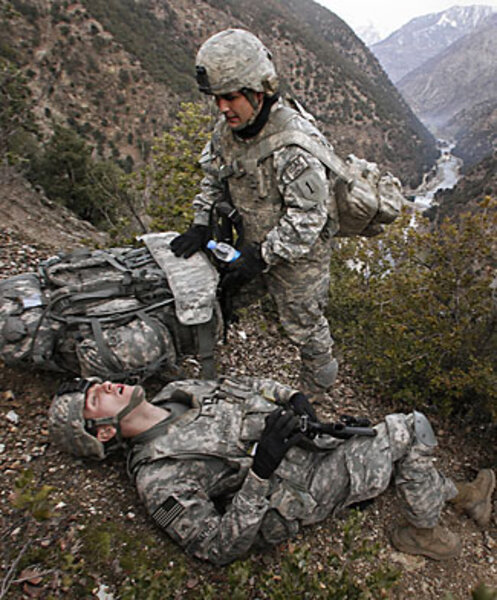How US tries to limit civilian deaths in Afghanistan
Loading...
| Camp Keating, Afghanistan
Keating, Fritsche, Lowell, Bostick, Cherry-Beasley. The list goes on and on. Almost every coalition forces' camp in Afghanistan is named for a life cut short.
Officers give briefings in front of plaques bearing the photographs of the dead. Camps are rechristened to memorialize their names. And flags are rarely seen fluttering at the top of their poles anymore.
The situation is getting worse. In recent months, coalition deaths here have outnumbered those in Iraq, and attacks in 2008 were up by 28 percent over the previous year, says Col. Skip Davis, strategic adviser to Gen. David McKiernan, who commands the approximately 70,000 troops in Afghanistan. A record 294 NATO soldiers were killed in Afghanistan last year; 155 were Americans, according to icasualties.org.
One of the reasons for the mounting number of coalition casualties, explain General McKiernan's staff, is the pressure not to hit civilians – coupled with the growing use of civilians either as proxy fighters or as human shields by the insurgents.
"In my area of operations, those doing much of the shooting and lobbing of rockets at our outposts are not, by and large, the enemy you might think they are," notes Maj. Matt McCollum, operations officer at Bostick, a Forward Operating Base (FOB) that oversees much of the volatile northeastern Kunar Province, which borders Pakistan.
Many are just local young men who have nothing to do and are being paid by the insurgents. "They do it for adventure, for the money, and just because they've been told it's cool to fight foreigners. It gets them street cred points."
Furthermore, adds Brig. Gen. Richard Blanchette, spokesman for the coalition forces in Afghanistan, these young men carry out their attacks from roofs or windows of houses with other civilians inside. "If we engaged, we would hit them back, but the constant problem is differentiating who is who."
Thousands of Afghan civilians have been killed since the start of the war in 2001, caught in the crossfire or in Taliban suicide attacks – but also, increasingly, victims of US airstrikes gone wrong, a fact that has precipitated a backlash against America and its partners. According to Human Rights Watch, 540 civilians lost their lives during the first six months of 2008 alone, a full 173 of them during coalition attacks – an outcome the coalition desperately wants to avoid.
"On the one hand," says Lt. Col. James Markert, commander of Task Force Raider, operating out of Bostick, "you need to disincentivize the insurgents. You need to strike back and make it clear they will take casualties, too." But, on the other, he adds, you have to think about broader goals. "I am not going to kill someone every time I take fire. Sometimes it's OK not to shoot back," he stresses.
The main alternative response involves redoubling efforts to "win" over villagers by offering them development projects and jobs, setting wages at about $170 a month, more than what the coalition believes is the going rate for attacking the bases. "We have more to offer than the Taliban, and we need to make it worth their while to come over to our side," says Major McCollum.
But it's not easy to convince young men to put down their weapons in return for a day laborer's job. "These guys are thinking, 'I could work with a shovel for eight hours and make some money – or I could lob a rocket over the ridge for same.' The latter appeals. It's easier, more exciting work," admits McCollum.
For coalition troops, meanwhile, showing restraint can be frustrating. "We came here to fight and engage an enemy, but we are learning ... we need to change our approach," says Lt. Col. Salvatore Petrovia, commander of Task Force Centaur, operating in Nuristan Province.
When his base was targeted by enemy mortar fire on a recent night, Colonel Petrovia told his troops hold their fire, and instead set off early the next morning in a convoy of Humvees.
"I elected not to fire, and instead investigate," he explains.
On the days leading up to the attack, Petrovia's troops had been out in the nearby villages handing out backpacks and pens to school kids. After the mortar attack, they returned to ask for help.
"We were hit last night, do you know anything about it?" Petrovia asked Afghan police officers stationed nearby. They were praying at the time, they reply, and heard nothing. "What about you guys?" he asks a group of schoolteachers, for whom the Americans are building a new building. Nothing.
Petrovia and his soldiers slowly hike up steep goat paths into the sandstone and shale mountains to search for where the mortar was fired. The day drags on, the paths end, the and progress is slow. There is no one to talk to, no sign of a launch.
"Employment is limited in these mountains. It's either the A Team, us, or the B Team, them," says Capt. Stephen Brewer, a physician's assistant from Texas. "And I guess a lot are working two jobs." Right now, he concludes, speaking slowly, it often seems Team A is losing players – but it will ultimately boil down, he believes, to which side can stick it out the longest.





